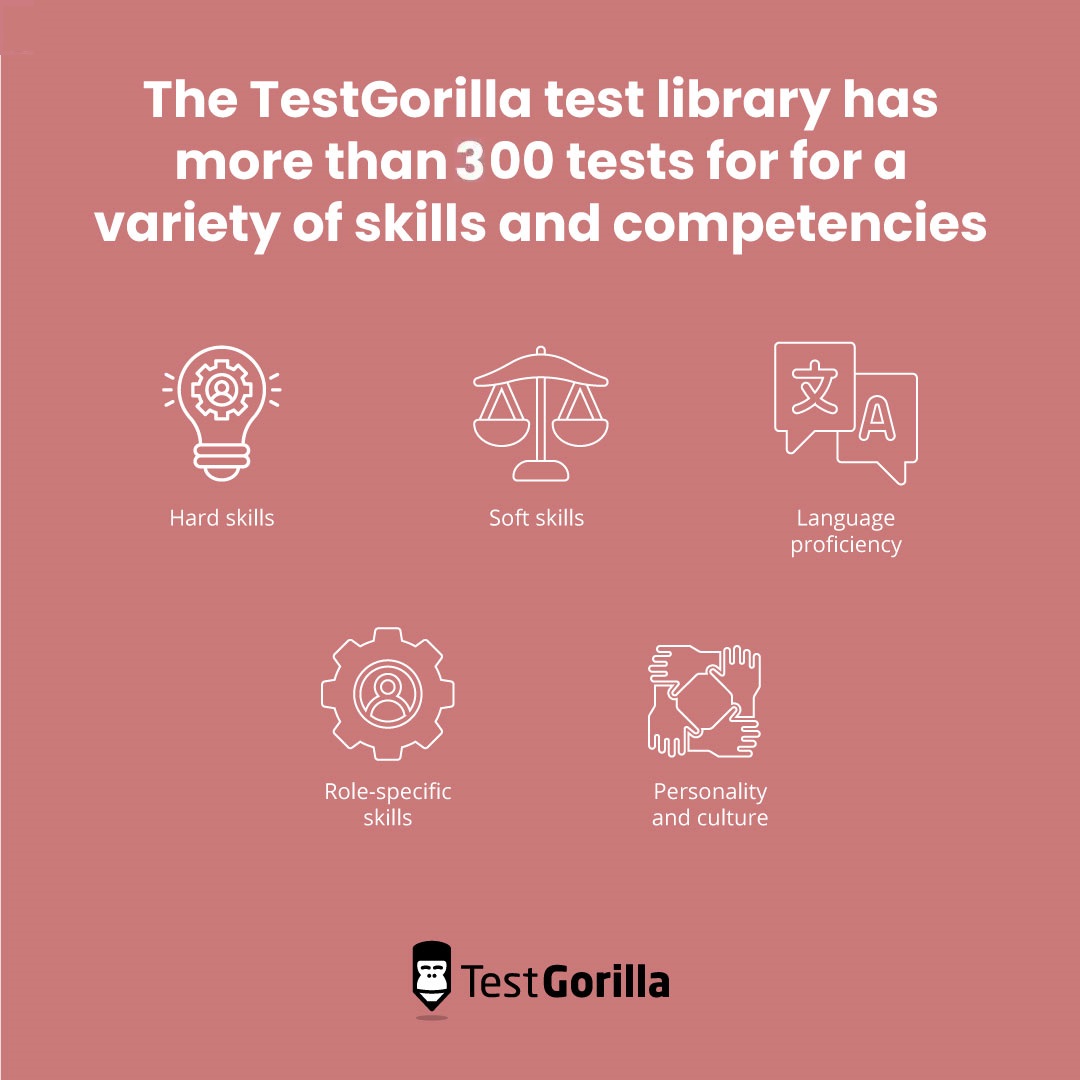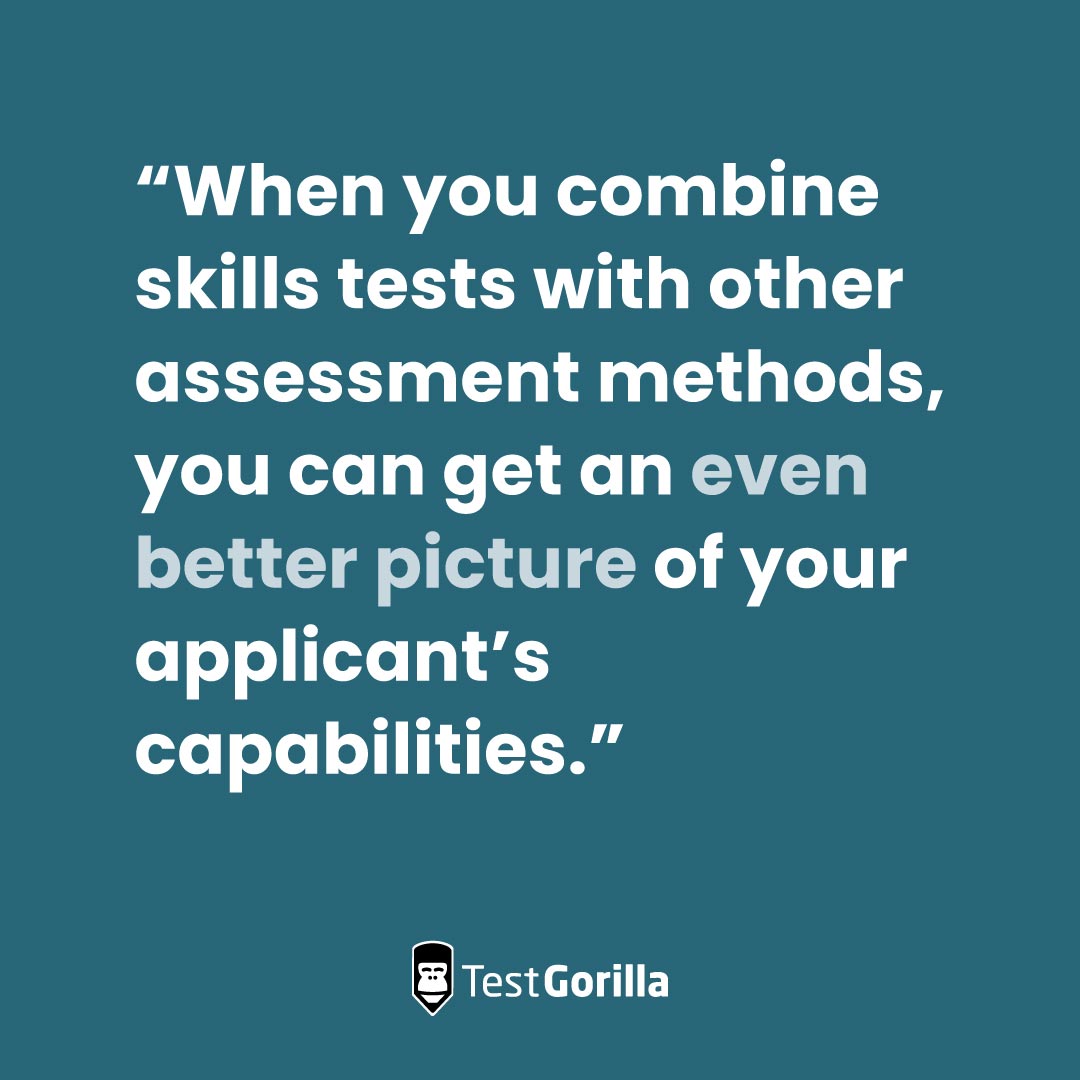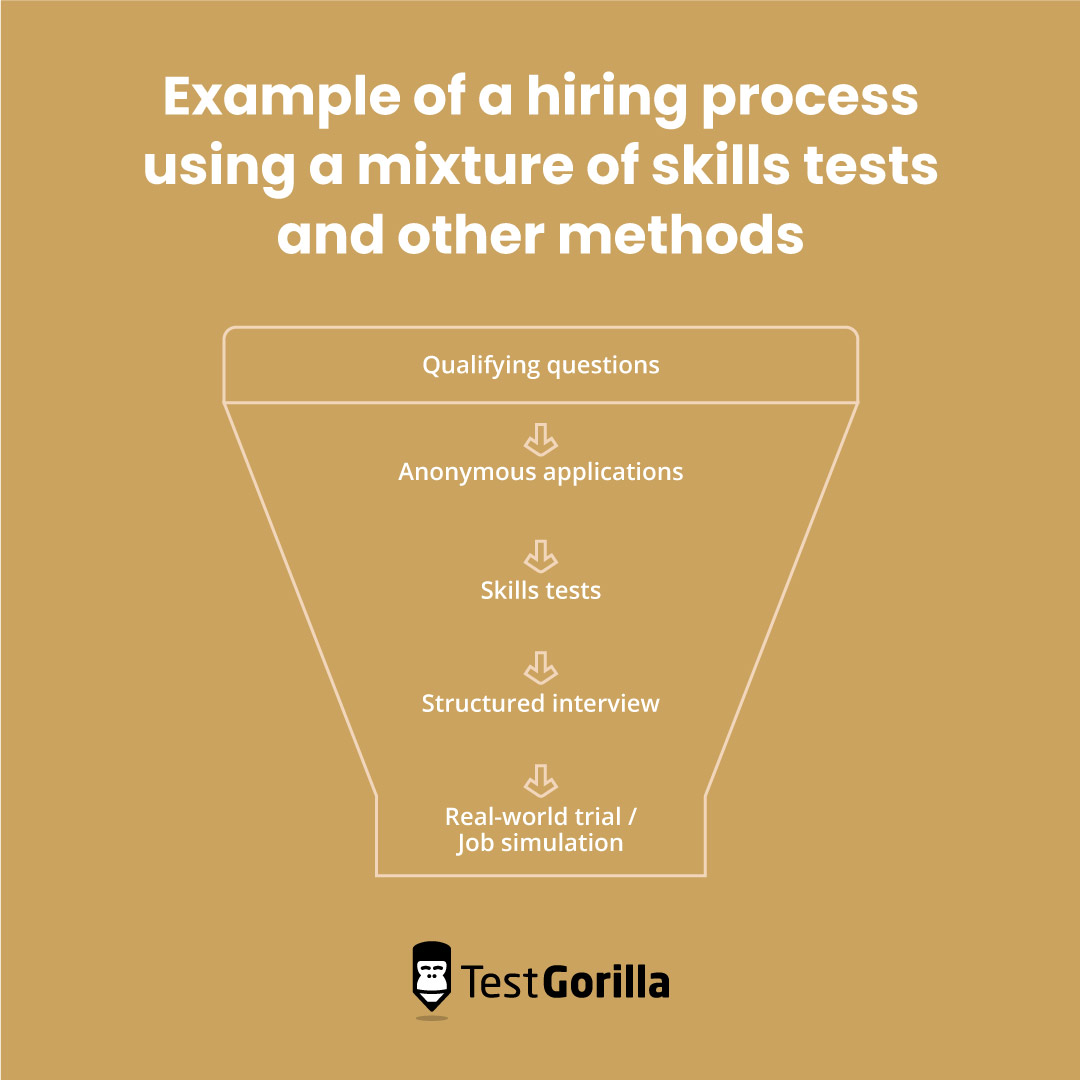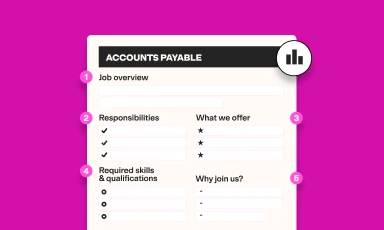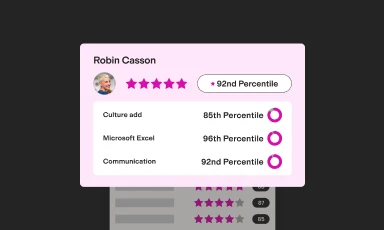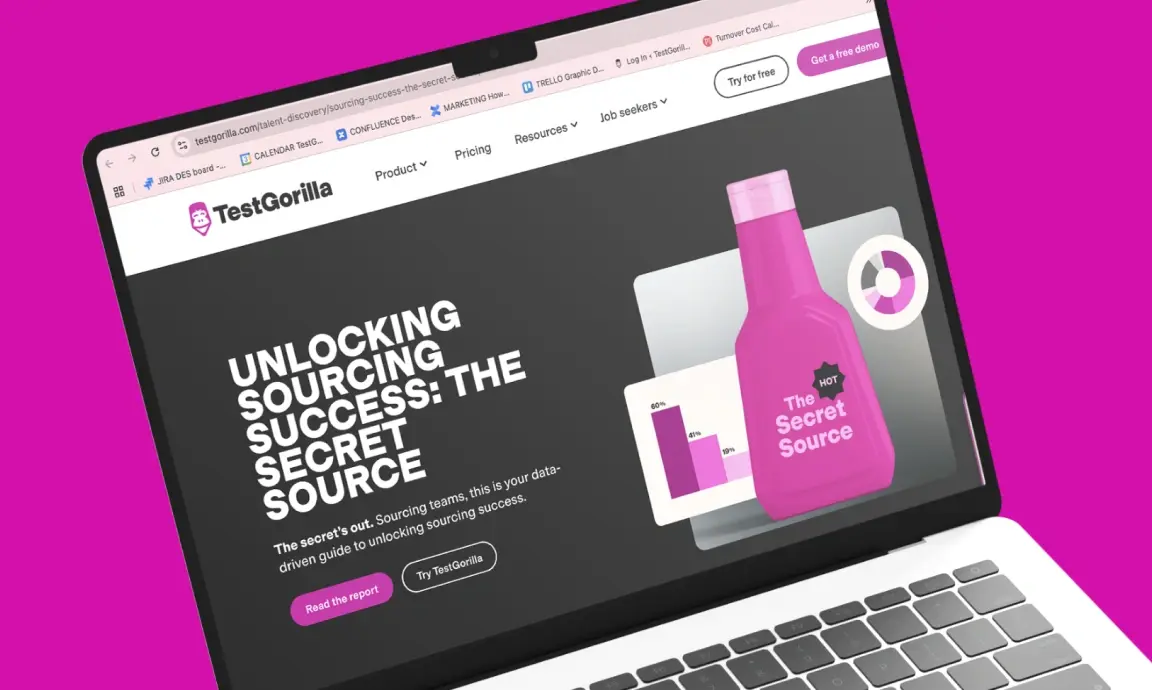Skills-based hiring is taking the world by storm.
According to TestGorilla’s State of Skills-Based Hiring report, 76% of companies use skills-based hiring, and 54.3% of candidates prefer a hiring process with skills tests.
Skills tests help you determine a candidate’s capabilities through a series of assessments and are essential to a skills-based hiring process.
But skills tests aren’t the only way to verify capabilities. An attention to detail test will help you evaluate a potential editor’s ability to process information and identify mistakes or inaccuracies, but what about their ability to edit in your brand voice?
When it comes to assessing these specific qualities, using additional testing methods in combination with skills tests leads to the best results.
This article discusses ways of assessing difficult-to-test skills and verifying an applicant’s knowledge after their skills assessment and how they fit into your skills-based hiring strategy.
Table of contents
Are skills tests the only way to assess skills?
Skills tests are the core of skills-based hiring and are the primary tool to assess a candidate’s capabilities.
You can use them to test for a variety of skills and competencies. Our test library has more than 300 tests for many different types of skills:
Hard skills
Soft skills
Language proficiency
Role-specific skills
Personality and culture
HR managers and recruiters select a handful of tests for each role and create assessments for their applicants, effectively replacing the need for resumes and ensuring they only interview capable prospects.
But are skills tests the only way to test for skills?
No, they’re not. Skills tests are an essential element in skills-based hiring, but their main limitation is assessing the practical application of knowledge.
Some skills are hard or impossible to test, and hiring managers need other methods to assess them properly, such as job trials and simulations.
For example, skills tests inform you of a warehouse worker’s time management skills, but a job trial verifies this capability in a realistic scenario.
Why use skills testing in conjunction with other methods?
When you combine skills tests with other assessment methods, you can get an even better picture of your applicant’s capabilities.
There are two main reasons to combine other methods with skills tests:
Confirm that a candidate has the practical skills to back up their theoretical knowledge
Determine skills that are untestable on a written test
Here are a few skills that are tough to verify with tests alone:
Editing: Attention to detail and communication are ways to assess an editor with tests, but you need a sample trial to see if an editor can handle your preferred style
Writing: Tests help you assess a writer’s copywriting skills, but you can test brand voice and fluency through a job simulation as those specifications vary from company to company.
Sales and negotiation: Our negotiation test evaluates a candidate’s knowledge of negotiation, but a real-world trial lets you see the applicant’s sales skills in action
Coding and programming: Our tests assess coding and programming skills, but job simulations can help verify this knowledge in a realistic trial
Proving a candidate’s skills with other methods, such as job trials or structured interviews, helps you validate their knowledge on the subject and confirm their capabilities.
Verifying skills is crucial when employers cite that their biggest hurdle to adopting skills-based hiring is properly validating the applicants’ skills.
Remember to always use structured interviews, job trials, and job simulations in conjunction with skills tests.
These methods aren’t standalone strategies for two primary reasons:
They don’t test the same variety of skills: Skills tests enable multi-measure testing or the ability to assess role-specific skills, cognitive ability, and personality. Multi-measure testing has been found to have the highest predictive validity of job performance, over reference checks and job experience, among others.[1]
They’re expensive to run: These other methods can be expensive to conduct, so it’s best to shortlist your applicants with skills tests first.
We always recommend screening and shortlisting candidates with skills tests and not resumes. Resumes invite bias and are unreliable at best.
So what if a role primarily consists of untestable skills?
You can still create a more high-level assessment of all the soft skills the position requires and then test the hard skills in the job trial.
For example, a warehouse worker needs many physical skills to get the job done, such as the ability to lift over fifty pounds or operate certain machinery. But a soft skill assessment could include tests like our Communication test and Time Management test.
This is crucial when many managers prioritize soft skills over hard skills, even in highly technical fields like software development.
According to TestGorilla’s State of Skills-Based Hiring report, 30.2% of hiring managers believe that soft skills are much more important to have in a candidate than it was five years ago. And 43.3% believe it’s somewhat more important.
The best insights on HR and recruitment, delivered to your inbox.
Biweekly updates. No spam. Unsubscribe any time.
What methods are there besides skills tests?
There are three main other methods for assessing skills besides pre-employment skills tests. Each one is useful for different occasions and roles, and you can even combine them.
Here’s a quick list of the methods we’ll take a look at:
Structured interviews
Real-world trials
Virtual job simulations
Structured interviews
Structured interviews are job interviews where questions are on a script, success criteria are determined in advance, and the questions focus on the core competencies of the role.
In a structured interview, you ask the questions in the same order for each applicant, and if you go off script, you always return.
Here’s a quick comparison between structured interviews and traditional unstructured interviews:
Structured interviews | Unstructured interviews |
Predetermined questions that were designed in advance | Unfolds like a casual conversation |
Focus on core competencies of the role | Has a few general topics to discuss |
The interviewer has predetermined criteria for answers | No specific questions |
Questions asked in the same order for each candidate | No agreed order |
Mostly behavioral and situational questions | No predetermined benchmarks for good answers |
Can go off-script, but will always get back on script |
So, how do structured interviews verify skills?
These interviews evaluate skills through behavioral and situational questions:
Behavioral questions: These verify past behavior and how the applicant has responded to challenges
Example: Can you tell me about a time you used [a relevant skill] and achieved a positive result?
Situational questions: These provide insight into how a candidate would react to possible situations
Example: Explain which approach you would take to overcome [a challenge for this particular role].
Both these types are important for a structured interview and help the interviewer better understand a candidate’s capabilities.
They help verify knowledge the applicant showed during the assessment or evaluate untestable soft skills, like how well a healthcare professional performs in an emergency.
Structured interviews work well, predicting up to 29% of job performance, whereas unstructured interviews predict only 14%.[2]
How do you conduct a structured interview? Let’s run through a quick step-by-step:
Analyze the role, and determine the required skills and the usual responsibilities
Start building your questions, and keep in mind possible follow-up questions to draw more insights out of the candidate
Consider your criteria and ranking system (we recommend a points system)
Determine the sequence of the questions
Carry out the interview and stick to your list of questions
Go off-script for in-depth insights and interesting points, but always return to your list
Evaluate candidates based on your scoring system
For more information on how to conduct a structured interview, check out our structured interview template.
Let’s take a look at the pros and cons of structured interviews.
Pros | Cons |
Higher predictor for job performance | Time-consuming to conduct |
Less unconscious bias | Expensive to set up |
Less reliance on charisma and confidence | |
Consistent questions across all candidates | |
Better insights into the applicant’s skills |
Real-world trials
Real-world job trials are brief assignments, where a candidate completes a relevant task for the company.
A real-world trial puts an applicant in a real situation, so they and the employer can see if the role matches their skill sets and personality.
Let’s describe the benefits a little more deeply:
Employers: Helps them verify if a candidate has the right skills for the role, whether they can handle the responsibilities, and contribute to the company culture
Employees: Gives them a chance to see if the role feels right, if the responsibilities are what they were expecting, and if the company is what they’re looking for
Real-world trials also enable real interaction. How does the candidate interact with their team and manager? How do they react, problem-solve, communicate, and take feedback?
It’s valuable to know how a candidate makes decisions, but this isn’t typically easy to assess in a written test.
Joor, a wholesale marketplace, cut its annual attrition from 60% to 10% using real-world job trials. Mona Bijoor, the founder and chief executive, said this method enables them to hire “rockstars” where traditional methods failed them.[3]
A trial can last anywhere from a few hours to a few months. It depends on the complexity of the role.
Most applicants expect payment for job trials, although some may volunteer for them. We believe in always paying candidates for their time. It gives a good impression and improves your brand image, increasing the likelihood that these candidates become positive brand ambassadors.
Let’s take a look at the pros and cons of real-world trials.
Pros | Cons |
Candidates experience responsibilities, culture, and environment firsthand | Time-consuming |
Employers can see a candidate in action | Can be difficult to arrange |
Candidates and employers can build rapport and a real relationship | Problematic if the candidate already has a job |
Virtual job simulations
A virtual job simulation gives candidates tasks and responsibilities similar to what the role entails to evaluate their skills.
In contrast to job trials, job simulations aren’t real-life situations but realistic simulated scenarios.
Here are a few examples of a role and its virtual job simulation:
Call center representative: A call support simulation where the candidate is confronted with possible problems and handling frustrated customers
Software developer: A simulation of a program with a bug where the candidate needs to find the source of the bug and fix the issue
Content writer: A simulation of writing an article, keeping in mind the fictitious client’s requirements, specifications, and brand voice
Some companies use software and tools to construct job simulations, but others create them internally.
The method is particularly useful for assessing creative and knowledge workers because simulations for writing, editing, programming, and design are simple to put together and fit the format well.
A combination of skills tests and job simulations is great for hiring contingent workers and helps hiring managers assess a contractor’s capabilities when resumes are unreliable, and references can be tricky to get a hold of.
Often, knowledge workers are freelancers. A recent survey found that 53% of contingent workers offer computer programming, marketing, IT, and business consulting.
For more insights, read our article on how to use skills-based hiring to effectively hire contingent workers.
One company that uses job simulations in its skills-based hiring approach is technology giant IBM.
IBM uses its internal pre-employment simulations to assess tech candidates. Instead of relying on resumes and the candidate’s own words, they conduct live tests to determine their skills.
IBM believes that resumes aren’t a good indicator of an applicant’s skills – real tests and simulations enable companies to discover real skills.
Let’s take a look at the pros and cons of virtual job simulations:
Pros | Cons |
Puts a candidate in a realistic scenario without as much investment as a real-world trial | Feedback and compatibility are not as easy to assess as in job trials |
Easy to assess remote and contingent positions | Depending on the simulation’s design, possible technical difficulties |
Able to assess many untestable skills |
Hiring process examples with skills tests and other methods
A skill-based hiring process cannot exist without skills tests, but these other methods help evaluate certain untestable skills.
So let’s put it all together.
Let’s take a quick look at a hiring process example using a mixture of skills tests and these other methods:
Qualifying questions: Qualifying questions help hiring managers to verify required criteria, such as a medical degree or driving license, before moving on to the application
Anonymous applications: Anonymous applications help reduce bias by leaving out questions about name, age, race, or gender
Skills tests: Role-relevant assessments help hiring managers evaluate candidates’ hard skills, soft skills, and personalities
Structured interview: Successful candidates move through to a structured interview, where each applicant is asked the same questions in the same order
Real-world trial / Job simulation: Depending on the role and your company, both types of trials would be a great way to cap off the hiring process
Personalize your hiring process to what suits your organization and the role best.
But remember: Skills tests should always come early in the process because they enable you to assess capability first, then shortlist the most skilled candidates.
Testing candidates after resume screening filters out too many excellent candidates. We recommend saying goodbye to the resume for good.
Combine skills tests with practical assessments to optimize recruitment
Skills tests are the most important tool for assessing capabilities, but they aren’t the only way to verify skills.
Combining skills tests with structured interviews, real-world trials, and job simulations enables you to evaluate hard-to-test skills, verify the applicant’s knowledge, and get a rounded picture of a candidate’s ability.
For more information on building a solid skills-based hiring process, read our article to find out if your skills-based hiring is just about adding skills tests to your current strategy.
To start browsing skills tests to add to your hiring process, check out our test library.
Sources
Martin, Whitney. (August 27, 2014). “The Problem with Using Personality Tests for Hiring”. Harvard Business Review. Retrieved April 11, 2023. https://hbr.org/2014/08/the-problem-with-using-personality-tests-for-hiring
Bock, Laszlo. (April 7, 2015). “Here’s Google’s Secret to Hiring the Best People”. Wired. Retrieved March 28, 2023. https://www.wired.com/2015/04/hire-like-google/
Max, Sarah. (September 10, 2014). “Uncertain About Hiring, Some Companies Try ‘Test Drives’”. The New York Times. Retrieved March 28, 2023. https://www.nytimes.com/2014/09/11/business/smallbusiness/uncertain-about-hiring-some-companies-try-test-drives.html
You've scrolled this far
Why not try TestGorilla for free, and see what happens when you put skills first.


